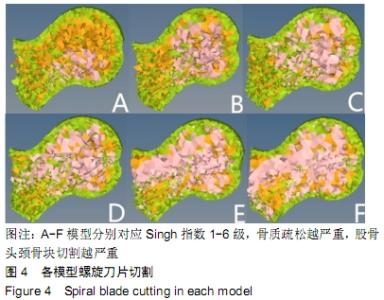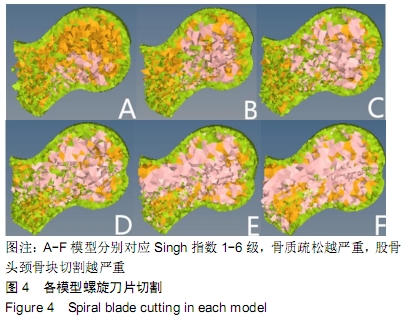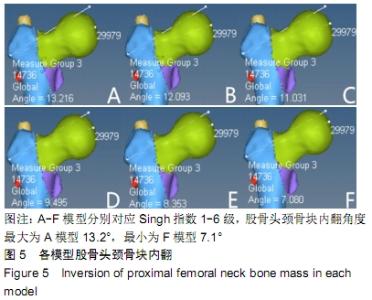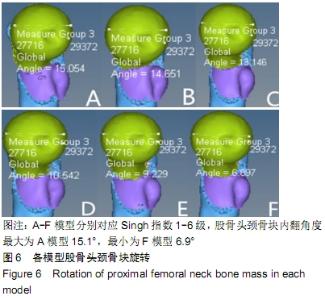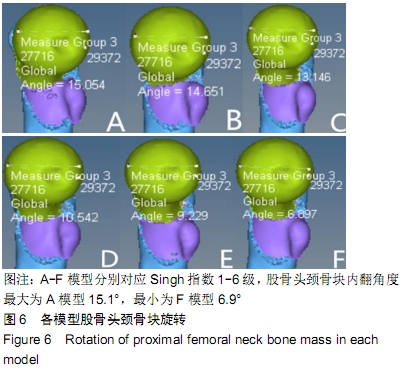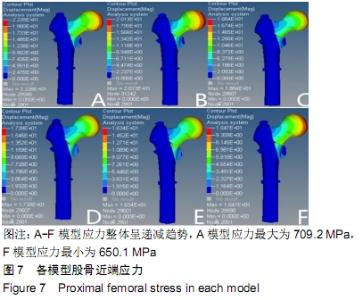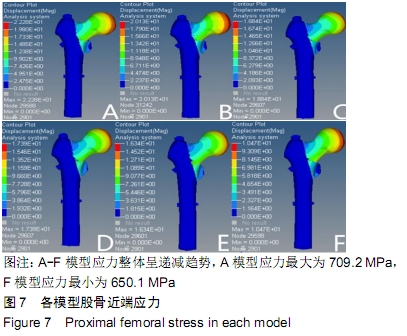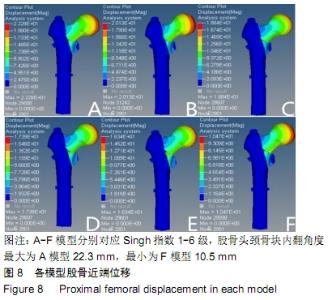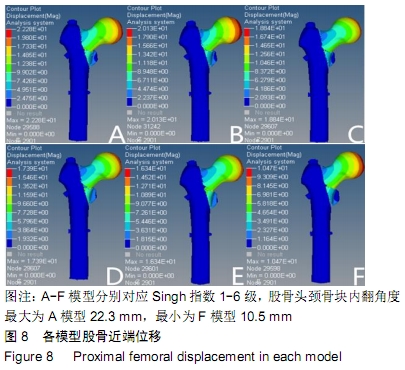Chinese Journal of Tissue Engineering Research ›› 2020, Vol. 24 ›› Issue (24): 3808-3814.doi: 10.3969/j.issn.2095-4344.2746
Previous Articles Next Articles
Osteoporosis effects on the treatment of intertrochanteric fracture of femur with proximal femoral anti- rotation intramedullary nail: a finite element simulation
Huang Peizhen1, Chen Xinmin2, Zheng Liqin2, Lin Ziling1, Dong Hang1, Cai Qunbin1, Li Musheng2, Zheng Yongze2
- 1the First Affiliated Hospital of Guangzhou University of Chinese Medicine, Guangzhou 510405, Guangdong Province, China; 2the First Clinical Medicine School, Guangzhou University of Chinese Medicine, Guangzhou 510405, Guangdong Province, China
-
Received:2019-11-18Revised:2019-11-21Accepted:2020-01-02Online:2020-08-28Published:2020-08-13 -
Contact:Lin Ziling, MD, Chief physician, Master’s supervisor, the First Affiliated Hospital of Guangzhou University of Chinese Medicine, Guangzhou 510405, Guangdong Province, China -
About author:Huang Peizhen, Master, Attending physician, the First Affiliated Hospital of Guangzhou University of Chinese Medicine, Guangzhou 510405, Guangdong Province, China -
Supported by:the National Natural Science Foundation of China, No. 81673996
CLC Number:
Cite this article
Huang Peizhen, Chen Xinmin, Zheng Liqin, Lin Ziling, Dong Hang, Cai Qunbin, Li Musheng, Zheng Yongze. Osteoporosis effects on the treatment of intertrochanteric fracture of femur with proximal femoral anti- rotation intramedullary nail: a finite element simulation[J]. Chinese Journal of Tissue Engineering Research, 2020, 24(24): 3808-3814.
share this article
| [1] WANG J, WANG Y, LIU WD, et al. Hip fractures in Hefei, China: the Hefei osteoporosis project. J Bone Miner Metab. 2014;32(2): 206-214. [2] XIA WB, HE SL, XU L, et al. Rapidly increasing rates of hip fracture in Beijing. China.J Bone Miner Res. 2012;27(1):125-129. [3] HERNLUND E, SVEDBOM A, IVERGÅRD M, et al. Osteoporosis in the European Union: medical management, epidemiology and economic burden. A report prepared in collaboration with the International Osteoporosis Foundation (IOF) and the European Federation of Pharmaceutical Industry Associations (EFPIA). Arch Osteoporos. 2013;8:136. [4] CLOSE JD, SWARTZ K, DEU R. Hip fracture in older patients: tips and tools to speed recovery. J Fam Pract. 2013;62(9): 484-492. [5] ADIB HAJBAGHERY M, ABBASINIA M. Quality of life of the elderly after hip fracture surgery: a case-control study. J Caring Sci. 2013;2(1):53-59. [6] WANG J, MA JX, LU B, et al. Comparative finite element analysis of three implants fixing stable and unstable subtrochanteric femoral fractures: Proximal Femoral Nail Antirotation (PFNA), Proximal Femoral Locking Plate (PFLP), and Reverse Less Invasive Stabilization System (LISS). Orthop Traumatol Surg Res. 2020; 106(1): 95-101. [7] GUO Y, YANG HP, DOU QJ, et al. Efficacy of femoral nail anti-rotation of helical blade in unstable intertrochanteric fracture. Eur Rev Med Pharmacol Sci. 2017;21(3 Suppl):6-11. [8] VÉLEZ M, PALACIOS-BARAHONA U, ARANGO-POSADA MM, et al. Functional results and complications of the use of the proximal femoral nail in the treatment of intertrochanteric hip fractures. Acta Ortop Mex. 2018;32(3):126-130. [9] XU R, RU J, JI F, et al. Comparison of efficacy, complications and TGF-β2 expression between DHS and PFNA in elderly patients with osteoporotic femoral intertrochanteric fracture. Exp Ther Med. 2018;16(1):394-399. [10] 段志斌.股骨近端防旋髓内钉术后螺旋刀片穿出股骨头的影响因素分析[D].南昌:南昌大学,2018. [11] 武政,刘向栋,常宝生.PFNA治疗高龄不稳定性股骨转子间骨折内固定失败的危险因素分析[J].局解手术学杂志, 2017,26(8):616-619. [12] 王炜昌,王荣生,石裕明,等. 股骨近端防旋髓内钉治疗老年股骨转子间不稳定骨折内固定失效的危险因素[J].临床骨科杂志,2019,22(4): 477-481. [13] 李磊,方诗元.Singh指数在骨质疏松性髋部骨折中的应用研究[J].中国骨质疏松杂志,2016,22(6):777-780. [14] 黄培镇,郑晓辉,董航,等.老年股骨转子间A1.2型骨折内固定失效原因分析[J].创伤外科杂志,2018,20(3):231-232. [15] 郑利钦,陈心敏,张彪,等.股骨转子间骨折股骨近端防旋髓内钉内固定切割失效的有限元仿真[J].中国组织工程研究,2019,23(36): 5794-5799. [16] 郑利钦,林梓凌,李鹏飞,等.动态载荷下松质骨对骨质疏松性股骨颈骨折断裂力学影响的有限元分析[J].中国组织工程研究,2019,23(12): 1887-1892. [17] 何祥鑫,李鹏飞,林梓凌,等.基于有限元分析法的老年粗隆间骨折建模仿真[J].中国医药导报,2017,14(24):88-91+195. [18] 马信龙,李海涛,马剑雄,等.股骨近端主压力骨小梁生物力学特性[J]. 生物医学工程与临床,2012,16(2):118-122. [19] BAYRAKTAR HH, MORGAN EF, NIEBUR GL, et al. Comparison of the elastic and yield properties of human femoral trabecular and cortical bone tissue. J Biomech. 2004;37(1):27-35. [20] EBERLE S, GERBER C, VON OLDENBURG G, et al. A Biomechanical evaluation of orthopaedic implants for hip fractures by finite element analysis andin-vitro tests. Proc Inst Mech Eng H. 2010;224(10):1141-1152. [21] NODA M, NAKAMURA Y, ADACHI K, et al. Biomechanical study using finite element method of element 'breakdown'technique on cutout mechanism after gamma nailing. EC Orthop. 2018: 458-466. [22] YENI YN, BROWN CU, NORMAN TL. Influence of bone composition and apparent density on fracture toughness of the human femur and tibia. Bone. 1998;22(1):79-84. [23] MCCALDEN RW, MCGEOUGH JA, BARKER MB, et al. Age-related changes in the tensile properties of cortical bone. The relative importance of changes in porosity, mineralization, and microstructure. J Bone Joint Surg Am. 1993;75(8):1193-1205. [24] MORGAN EF, KEAVENY TM. Dependence of yield strain of human trabecular bone on anatomic site. J Biomech. 2001;34(5): 569-577. [25] DONG XN, GUO XE. The dependence of transversely isotropic elasticity of human femoral cortical bone on porosity. J Biomech. 2004;37(8):1281-1287. [26] KAWABATA Y, MATSUO K, NEZU Y, et al. The risk assessment of pathological fracture in the proximal femur using a CT-based finite element method. J Orthop Sci. 2017;22(5):931-937. [27] MA Z, CHEN J, LAN F. Biomechanical response and injury of occupant's pelvis in side impacts: effects of the femoral head and loading conditions. J Mech Med Biol.2014;14(6):1440001. [28] SHIBO G, XUANHUI Q, XINBO H, et al. Powder injection molding of Ti-6Al-4V alloy. J Mater Proc Technol. 2006;173(3):310-314. [29] HINÜBER C, KLEEMANN C, FRIEDERICHS RJ, et al. Biocompatibility and mechanical properties of diamond-like coatings on cobalt-chromium-molybdenum steel and titanium-aluminum-vanadium biomedical alloys. J Biomed Mater Res A. 2010;95(2):388-400. [30] GOFFIN JM, PANKAJ P, SIMPSON AH, et al. Does bone compaction around the helical blade of a proximal femoral nail anti-rotation (PFNA) decrease the risk of cut-out?: A subject- specific computational study. Bone Joint Res. 2013;2(5):79-83. [31] CARNEY KS, PEREIRA JM, REVILOCK DM, et al. Jet engine fan blade containment using an alternate geometry. Int J Impact Eng. 2009; 36(5):720-728. [32] HELGASON B, VICECONTI M, RÚNARSSON TP, et al. On the mechanical stability of porous coated press fit titanium implants: a finite element study of a pushout test. J Biomech. 2008;41(8): 1675-1681. [33] BOBBILI R, RAMAKRISHNA B, MADHU V. Dynamic compressive behavior and fracture modeling of Titanium alloy IMI 834. J Alloys Comp. 2017;714:225-231. [34] NAHAS EA, KAWAKAMI MS, NAHAS-NETO J, et al. Assessment of risk factors for low bone mineral density in Brazilian postmenopausal women. Climacteric. 2011;14(2):220-227. [35] WHITMARSH T, FRITSCHER KD, HUMBERT L, et al. A statistical model of shape and bone mineral density distribution of the proximal femur for fracture risk assessment. Med Image Comput Comput Assist Interv. 2011;14(Pt 2):393-400. [36] YU Z, WANG G, TANG T, et al. Long-term effects of ovariectomy on the properties of bone in goats. Exp Ther Med.2015;9(5): 1967-1973. [37] BURR DB. Bone material properties and mineral matrix contributions to fracture risk or age in women and men. J Musculoskelet Neuronal Interact. 2002;2(3):201-204. [38] 刘奋斗,丁海.骨生物力学特性在骨质疏松症中的改变[J].医用生物力学,2017,32(4):388-392. [39] 曹立,雍宜民,沈惠良.老年股骨颈骨折骨密度、Singh指数的研究[J]. 中国骨质疏松杂志,2001,7(2):10-13. [40] 任翔,谢芳,张聪,等.Singh指数在股骨转子间骨折治疗的应用[J].中国矫形外科杂志,2011,19(22):1929-1931. [41] 刘文和,刘忠厚,陈鹏,等.老年人骨质疏松性髋部骨折与Singh指数和股骨近端几何结构的相关性初探[J].中国骨质疏松杂志,2012,18(3): 193-196. [42] 徐丛,徐飞,杜元良,等.绝经后女性不同Singh指数骨扫描电镜特点[J]. 中国老年学杂志,2016,36(4):936-938. [43] 康颖安.断裂力学的发展与研究现状[J].湖南工程学院学报(自然科学版),2006,16(1):39-42. [44] CHRISTOPHER JJ, RAMAKRISHNAN S. Assessment and classification of mechanical strength components of human femur trabecular bone using texture analysis and neural network. J Med Syst. 2008;32(2):117-122. [45] 丁海,朱振安,薛晶,等.骨质疏松症对松质骨骨小梁应力与微损伤关系的影响[J].医用生物力学,2015,30(1):68-73. [46] THOMAS CD, MAYHEW PM, POWER J, et al. Femoral neck trabecular bone: loss with aging and role in preventing fracture. J Bone Miner Res.2009;24(11):1808-1818. [47] 刘凤祥,唐坚,孙月华.股骨转子间骨折内固定的影响因素[J].国际骨科学杂志,2016,37(3):141-144+170. [48] 李宁,罗汉文,岑景胜.老年股骨转子间骨折闭合复位内固定术后内固定失败的影响因素分析[J].吉林医学,2017,38(8):1413-1414. [49] FUJII T, NAKAYAMA S, HARA M, et al. Tip-apex distance is most important of six predictors of screw cutout after internal fixation of intertrochanteric fractures in women. JB JS Open Access. 2017; 2(4):e0022. [50] TSAI SW, LIN CJ, TZENG YH, et al. Risk factors for cut-out failure of Gamma3 nails in treating unstable intertrochanteric fractures: An analysis of 176 patients. J Chin Med Assoc. 2017;80(9): 587-594. [51] 张世民,张英琪,李清,等.内侧皮质正性支撑复位对老年股骨粗隆间骨折内固定效果的影响[J].中国矫形外科杂志,2014,22(14): 1256-1261. [52] 杨红军,苏高建,冯智海,等.新型骨水泥椎弓根螺钉内固定系统治疗重度骨质疏松腰椎退变性疾病的临床研究[J].中国骨与关节杂志, 2019,8(9):703-708. [53] 王勇,潘骏.标准骨水泥强化型PFNA治疗老年股骨粗隆间不稳定骨折[J].中国矫形外科杂志,2018,26(18):1653-1658. [54] 裴葆青,王田苗,王军强.松质骨微观骨小梁结构的生物力学有限元分析[J].北京生物医学工程,2008,27(2):120-122. |
| [1] | Chen Xinmin, Li Wenbiao, Xiong Kaikai, Xiong Xiaoyan, Zheng Liqin, Li Musheng, Zheng Yongze, Lin Ziling. Type A3.3 femoral intertrochanteric fracture with augmented proximal femoral nail anti-rotation in the elderly: finite element analysis of the optimal amount of bone cement [J]. Chinese Journal of Tissue Engineering Research, 2021, 25(9): 1404-1409. |
| [2] | Tang Hui, Yao Zhihao, Luo Daowen, Peng Shuanglin, Yang Shuanglin, Wang Lang, Xiao Jingang. High fat and high sugar diet combined with streptozotocin to establish a rat model of type 2 diabetic osteoporosis [J]. Chinese Journal of Tissue Engineering Research, 2021, 25(8): 1207-1211. |
| [3] | Li Zhongfeng, Chen Minghai, Fan Yinuo, Wei Qiushi, He Wei, Chen Zhenqiu. Mechanism of Yougui Yin for steroid-induced femoral head necrosis based on network pharmacology [J]. Chinese Journal of Tissue Engineering Research, 2021, 25(8): 1256-1263. |
| [4] | Cai Qunbin, Zou Xia, Hu Jiantao, Chen Xinmin, Zheng Liqin, Huang Peizhen, Lin Ziling, Jiang Ziwei. Relationship between tip-apex distance and stability of intertrochanteric femoral fractures with proximal femoral anti-rotation nail: a finite element analysis [J]. Chinese Journal of Tissue Engineering Research, 2021, 25(6): 831-836. |
| [5] | Hou Guangyuan, Zhang Jixue, Zhang Zhijun, Meng Xianghui, Duan Wen, Gao Weilu. Bone cement pedicle screw fixation and fusion in the treatment of degenerative spinal disease with osteoporosis: one-year follow-up [J]. Chinese Journal of Tissue Engineering Research, 2021, 25(6): 878-883. |
| [6] | Song Chengjie, Chang Hengrui, Shi Mingxin, Meng Xianzhong. Research progress in biomechanical stability of lateral lumbar interbody fusion [J]. Chinese Journal of Tissue Engineering Research, 2021, 25(6): 923-928. |
| [7] | Liu Zhao, Xu Xilin, Shen Yiwei, Zhang Xiaofeng, Lü Hang, Zhao Jun, Wang Zhengchun, Liu Xuzhuo, Wang Haitao. Guiding role and prospect of staging and classification combined collapse prediction method for osteonecrosis of femoral head [J]. Chinese Journal of Tissue Engineering Research, 2021, 25(6): 929-934. |
| [8] | Li Shibin, Lai Yu, Zhou Yi, Liao Jianzhao, Zhang Xiaoyun, Zhang Xuan. Pathogenesis of hormonal osteonecrosis of the femoral head and the target effect of related signaling pathways [J]. Chinese Journal of Tissue Engineering Research, 2021, 25(6): 935-941. |
| [9] | Xiao Fangjun, Chen Shudong, Luan Jiyao, Hou Yu, He Kun, Lin Dingkun. An insight into the mechanism of Salvia miltiorrhiza intervention on osteoporosis based on network pharmacology [J]. Chinese Journal of Tissue Engineering Research, 2021, 25(5): 772-778. |
| [10] | Liu Bo, Chen Xianghe, Yang Kang, Yu Huilin, Lu Pengcheng. Mechanism of DNA methylation in exercise intervention for osteoporosis [J]. Chinese Journal of Tissue Engineering Research, 2021, 25(5): 791-797. |
| [11] | Zhang Guomei, Zhu Jun, Hu Yang, Jiao Hongwei. Stress of three-dimensional finite element models of E-MAX porcelain inlay [J]. Chinese Journal of Tissue Engineering Research, 2021, 25(4): 537-541. |
| [12] | Nie Shaobo, Li Jiantao, Sun Jien, Zhao Zhe, Zhao Yanpeng, Zhang Licheng, Tang Peifu. Mechanical stability of medial support nail in treatment of severe osteoporotic intertrochanteric fracture [J]. Chinese Journal of Tissue Engineering Research, 2021, 25(3): 329-333. |
| [13] | Chen Lu, Zhang Jianguang, Deng Changgong, Yan Caiping, Zhang Wei, Zhang Yuan. Finite element analysis of locking screw assisted acetabular cup fixation [J]. Chinese Journal of Tissue Engineering Research, 2021, 25(3): 356-361. |
| [14] | Cheng Shigao, , Wang Wanchun, Jiang Dong, Li Tengfei, Li Xun, Ren Lian. Comparison of the standard and long-stem bone cement prosthesis replacement in the treatment of intertrochanteric fractures in elderly patients [J]. Chinese Journal of Tissue Engineering Research, 2021, 25(3): 362-367. |
| [15] | Lü Jiaxing, Bai Leipeng, Yang Zhaoxin, Miao Yuesong, Jin Yu, Li Zhehong, Sun Guangpu, Xu Ying, Zhang Qingzhu. Evaluation of internal fixation with proximal femoral nail antirotation in elderly knee osteoarthritis patients with femoral intertrochanteric fractures [J]. Chinese Journal of Tissue Engineering Research, 2021, 25(3): 391-396. |
| Viewed | ||||||
|
Full text |
|
|||||
|
Abstract |
|
|||||
